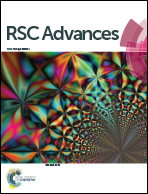High performance Na-doped lithium zinc titanate as anode material for Li-ion batteries
Abstract
A series of Li2−xNaxZnTi3O8 (x = 0, 0.05, 0.10, 0.15, 0.20) are prepared for the first time by a simple solid state method. Upon Na-doping, Rietveld refinement reveals that Na+ takes the 8c tetrahedral sites shared with Li+ and Zn2+ in the structure. Due to the larger ionic radius of Na+ than that of Li+, an increased disorder degree of ion locations in the structure is induced by Na doping. Furthermore, the lithium ion diffusion tunnel is also expanded after Na doping. Thus, higher lithium ion diffusion coefficient can be observed for all the Na-doped Li2ZnTi3O8 samples. However, phase analysis shows that high Na-doping content can result in the formation of impurity in the as-obtained titanates. Besides, the existence of too many Na ions in the spinel also decreases the structural stability. Therefore, Na-doping with low dose is beneficial to improve the electrochemical performance of Li2ZnTi3O8. Electrochemical evaluations show that Li1.95Na0.05ZnTi3O8 has the best lithium storage property among all the Li2−xNaxZnTi3O8. It can be found that Li1.95Na0.05ZnTi3O8 can deliver a reversible capacity of 267.3 mA h g−1 after 50 cycles. This finding can provide an experimental support to synthesize high performance Ti-based materials by Na doping.


 Please wait while we load your content...
Please wait while we load your content...